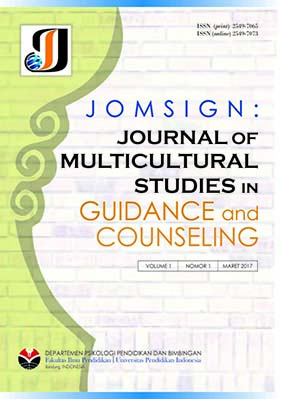JOMSIGN: Journal of Multicultural Studies in Guidance and Counseling is published by Departemen Psikologi Pendidikan dan Bimbingan, Universitas Pendidikan Indonesia (UPI) in collaboration with the Asosiasi Bimbingan dan Konseling Indonesia (ABKIN). JOMSIGN is interdisciplinary forum for educators, counselor, psychologists, and sociologists who study how cultural differences in the educational, development, and social experience, affect the behavior of the individual. The JOMSIGN focuses on issues of cross-culture that is important today, including individualism, self improvement, acculturation, family values change, a comparison of ethnic groups, gender differences, and personality. The JOMSIGN has been equipped with ISSN 2549-7065 (print) and ISSN 2549-7073 (online). The journal was published regularly twice a year, in March and September.
Guidance and Counseling Study Program Universitas Pendidikan Indonesia Jl. Dr. Setiabudi no. 229 Kota Bandung
If the author has difficulty registering an account, please contact the admin via email jomsign@upi.edu

JOMSIGN: Journal of Multicultural Studies in Guidance and Counseling was indexed and/or available catalogue in:
JOMSIGN is an Open Access Journal. The authors who publish the manuscript in this journal agree to the following terms:
JOMSIGN is licensed under a Creative Commons Attribution 4.0 International License. This permits anyone to copy, redistribute, remix, transmit and adapt the work provided the original work and source is appropriately cited.

Announcements
CALL FOR PAPER 2026 |
|
JOMSIGN VOL. 9 NO 1 AT MARCH 2026 JOMSIGN VOL. 9 NO 2 AT SEPTEMBER 2026 |
|
| Posted: 2025-07-08 | More... |
| More Announcements... |
Vol 9, No 2 (2025)
Table of Contents
Articles
|
Amierah Joy Aliser
|
139-152
|
|
Riesa Siddik, Azni Nurul Fauzia, Dona Fitri Annisa
|
153-162
|
|
Isna Rahmi
|
163-172
|
|
Sedem Nunyuia Amedome
|
173-186
|
|
Aisyah Ma'awiyah
|
187-196
|
|
Abdillah Arif
|
197-204
|
|
Mutmainnahh Mutmainnahh
|
205-220
|
|
Suehartono Syam, Awaluddin Hasrin, Sudharmono Sudharmono
|
221-228
|
|
Novi Sylvia, Deni Hadiana
|
229-240
|
|
Nur Kholifah, Ulfah Ulfah
|
241-248
|













